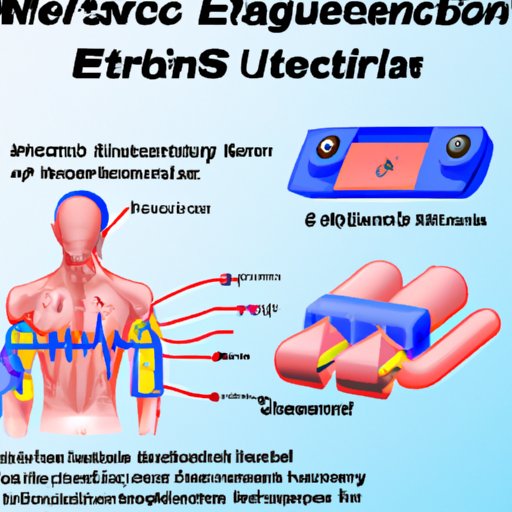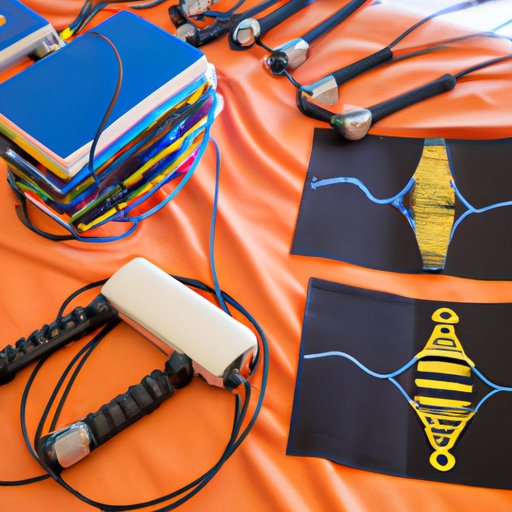Introduction
Electro muscle stimulation (EMS) is a technique used to stimulate the muscles with electric signals. It is a science-backed technique that has been used for decades in medical rehabilitation, physical therapy, and athletic training. By applying electrical pulses to the skin, EMS can help strengthen and develop muscles, increase range of motion, relieve pain, and aid in muscle recovery. In this article, we’ll explore the science behind EMS, how it works, the different types of EMS, and their uses.
Exploring the Science Behind Electro Muscle Stimulation
Before we dive into the specifics of how EMS works, let’s discuss the science behind it. The basis of EMS is simple: electrodes are placed on the skin and send electrical signals to the underlying muscles, which causes them to contract. This process is known as neuromuscular excitation. Depending on the intensity of the electrical signal and the frequency of the pulses, the resulting muscle contractions can be either strong or weak.
The electrical signals used in EMS come in various forms, including alternating current (AC), direct current (DC), and pulsed current. AC is a type of current that alternates direction periodically, while DC is a type of current that flows in one direction only. Pulsed current is a combination of AC and DC, and is often used in EMS because it can produce stronger muscle contractions than AC or DC alone.
When considering EMS, it’s important to understand the potential benefits and risks associated with the procedure. On the plus side, EMS can help improve muscle strength, flexibility, and performance, as well as providing relief from pain and aiding in muscle recovery. However, there are also risks that come with using EMS, such as skin irritation, muscle soreness, and even nerve damage if the procedure is not done correctly.

A Comprehensive Guide to How Electro Muscle Stimulation Works
Now that we’ve explored the science behind EMS, let’s take a look at how it works in practice. EMS is typically performed using a device that consists of two electrodes connected to a power source. The electrodes are placed on the skin near the target muscle group, and an electrical signal is sent through the electrodes. The signal passes through the skin and stimulates the underlying muscles, causing them to contract.
The intensity of the electrical signal and the frequency of the pulses can be adjusted depending on the desired result. For example, lower intensities and frequencies can be used to gently stimulate the muscles, while higher intensities and frequencies can be used to achieve stronger contractions. It’s important to note that the intensity of the electrical signal should never exceed the recommended level, as this could cause discomfort or even injury.
EMS can also be used to help with muscle recovery. After a workout, the body needs time to repair and rebuild the muscles. EMS can help speed up this process by stimulating the muscles and increasing blood flow, which helps to reduce inflammation and promote healing. It can also help to reduce muscle soreness and fatigue, allowing you to get back to your workouts faster.

Different Types of Electro Muscle Stimulation and Their Uses
There are several different types of EMS, each of which has its own set of benefits and uses. Transcutaneous Electrical Nerve Stimulation (TENS) is a type of EMS that is used to treat chronic pain. It works by sending low-frequency electrical signals to the nerves, which can help to reduce inflammation and provide relief from pain.
Interferential Current (IFC) is another type of EMS that is used to treat muscle and joint pain. It works by sending electrical signals of different frequencies to the affected area, which can help to reduce inflammation and stimulate healing.
Neuromuscular Electrical Stimulation (NMES) is a type of EMS that is used to strengthen and develop muscles. It works by sending high-frequency electrical signals to the muscles, which causes them to contract and relax repeatedly. This helps to build strength, endurance, and flexibility.
Conclusion
EMS is a science-backed technique that has many potential benefits and uses. It can be used to strengthen and develop muscles, increase range of motion, relieve pain, and aid in muscle recovery. While there are some risks associated with EMS, when used properly it can be an effective tool for improving overall health and fitness.
(Note: Is this article not meeting your expectations? Do you have knowledge or insights to share? Unlock new opportunities and expand your reach by joining our authors team. Click Registration to join us and share your expertise with our readers.)
